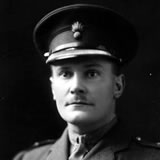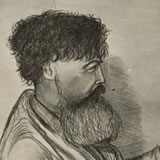Te Whiti-o-Rongomai
Te Whiti (?–1907), born during the turmoil of the 'musket wars', was of the Taranaki tribe Te Āti Awa. It is said he was identified as a teacher and prophet early in life, and much care was taken to ensure his safety. His stature in the Māori traditional world was enhanced by his deep knowledge of Christian doctrine. Te Whiti was said to have taken part in the Taranaki wars of the 1860s, but by the mid-1860s he had decided to pursue peaceful resistance to European incursion and the loss of land.
One tradition has it that Te Whiti and his people first moved to the inland village later known as Parihaka in the 1840s, to escape the social and economic pressures of coastal life. Other sources say he began living there in the 1860s after the Taranaki wars and subsequent land confiscations. In any event Parihaka became a centre of peaceful resistance and a rallying point for many Māori. Parihaka was led by Te Whiti and his relative and fellow prophet Tohu Kakahi. The main focus of Māori discontent was land confiscation and the government's failure to set aside promised reserves.
In 1879 the government began to survey 16,000 acres of the confiscated Waimate Plain without setting aside Māori reserves. In response, Māori, led by Te Whiti and Tohu, began ploughing land occupied by settlers. Arrests followed, but the pace of protest continued to grow. Parihaka became a symbol for many Māori, and its people received food and other supplies from many tribes throughout the country – including those as far away as the Chatham Islands.
On 5 November 5 1881 a force of almost 1,600 Armed Constabulary and volunteers, led by Native Minister John Bryce, invaded Parihaka. The Māori inhabitants, numbering about 2,000, put up no resistance. Instead they greeted Bryce and his men with bread and song. They were dispersed and Te Whiti and Tohu were arrested. The soldiers then systematically wrecked the settlement, and Māori tradition speaks of brutality and rape.
Te Whiti was charged with 'wickedly, maliciously, and seditiously contriving and intending to disturb the peace'. Held without trial, he was not released until 1883, when he returned to the ruined Parihaka settlement. Te Whiti and Tohu continued to lead peaceful Māori protest, and Te Whiti was imprisoned again for six months in 1886. In 1892 the West Coast Settlement Reserves Act brought in a system of renewable leases to settlers on over 200,000 acres of Māori land. Māori persisted with the ploughing campaigns in protest at the Act. In 1897, 92 Māori were arrested for ploughing in protest at delays in resolving the grievances over the Native Trustee's management of these leases.
Te Whiti and Tohu died in 1907 within a few months of each other. The white albatross feather, which Te Whiti’s followers adopted as a symbol protecting the mana of the Parihaka settlement, remains an enduring emblem among Te Āti Awa.
Te Whiti-o-Rongomai
Ka whānau mai a Te Whiti (?-1907) i te wā o ngā pakanga mau pū i waenganui i ngā iwi. Ko tōna iwi ko Te Āti Awa o Taranaki. E ai ki ngā kōrero, e tamariki tonu ana a Te Whiti ka puta i a ia ngā tohu o te matakite, o te poropiti. I āta manaakitia ia e tōna iwi. I tua atu, he tangata matatau ia ki te whakapono Karaitiana; kātahi ka nui atu ngā rongo kōrero mōna i te ao Māori. E ai ki te kōrero, i roto a Te Whiti i ngā riri ki Taranaki i te tekau tau atu i 1860. Heoti, tae rawa ki te pokapū o taua tekau tau, kua huri kē ia ki te mautohe mārie ki te tomo mai o te Pākehā me te rironga o ngā whenua.
Tērā tētahi kōrero e mea ana i whakatūria te kāinga o Parihaka e Te Whiti mā i te tekau tau atu i 1840, hei wāhi haumaru i ngā whakararu ki takutai. Tērā tētahi atu kōrero e mea ana, nō muri rawa i ngā riri me te raupatunga whenua o te tekau tau atu i 1860, ka tū tōna kāinga i Parihaka. Ahakoa he aha, ka tipu a Parihaka hei pokapū mō ngā mautohe mārie a te iwi Māori. Ko Te Whiti rāua ko tōna pāpā a Tohu Kakahi ngā kaiārahi. Rite a Tohu rāua ko Te Whiti, he matakite. Ko te take nui ki te iwi Māori ko ngā whenua i raupatutia me te kore tutuki i te kāwanatanga tana kī taurangi mō ngā whenua ka rāhuitia mō te Māori.
I te tau 1879 ka tīmata te kāwanatanga ki te rūri i te whenua raupatu e 16,000 eka te rahi i ngā mānia o Waimate. Kāore i rāhuitia he wāhanga o tēnei whenua mō te Māori. Hei utu mō tēnei, ka tīmata a Te Whiti rātou ko Tohu, ko te iwi ki te parau i ngā whenua kei te nōhia e te Pākehā. Ka mauherea ētahi. Hāunga tērā, ka nui haere ngā mautohe, ka tū a Parihaka hei tohu whakakaha i te tini o te iwi Māori. Ka tukua mai e tēnā iwi, e tēnā iwi he kai, tae rawa ki Wharekauri.
I te rā 5 o Nōema o te tau 1881 ka whakaekea a Parihaka e ngā Pirihimana Mau Pū me ngā tūao e 1600 te rahi; ko tō rātou kaiārahi ko te Minita mō ngā Take Māori, a Te Paraihe (John Bryce). Kāore i ātetetia tō rātou kuhu e te iwi o Parihaka e 2000 pea te tokomaha. Ka horahia ngā kai mā Te Paraihe me tōna ope, ka waiatatia rātou. Kia ahatia. Whakamararatia ana te iwi, mauheretia ana a Te Whiti rāua ko Tohu. Wāwāhia ana te kāinga o Parihaka. Kei te mau tonu ngā kōrero tuku iho mō ngā mahi whakarihariha a ngā hōia, tā rātou tūkino i ngā wāhine.
Ka ūhia ngā whakapae ki runga i a Te Whiti mō te "whakatutū i te puehu i runga i te kino, i te ngākau waniwani". Ka mauherea ia, hāunga te mea kāore anō kia tū he whakawākanga. Nō te tau 1883 ka tukua ia. I tana hokinga kua pākarukaru katoa a Parihaka. Ka ārahi tonu a Te Whiti rāua ko Tohu i ngā mautohe mārire, whai anō i te tau 1886 ka whiua anōtia a Te Whiti ki te whare herehere mō te ono marama. Nā te Ture Whakatau Papa Rāhui o te Tai Hauāuru o te tau 1892, ka tareka e ngā tāngata whai te whakahou i ā rātou rīhi i runga i ngā whenua Māori e 200,000 eka. Hei ātete i te ture nei, ka haere tonu ngā mautohe mārire a ngā Māori. I te tau 1897, e 92 ngā tāngata Māori i mauherea mō te parau whenua; i mautohe nā te takaroa o te whakatau i ō rātou nawe mō ngā whakahaere a te Kaitiaki Māori i ngā rīhi nei.
Nō te tau 1907 i mate ai a Te Whiti rāua ko Tohu. Ko te raukura toroa te tohu a ngā pononga o Te Whiti e whakaū ana i te mana o Parihaka, e mau tonu nei i roto o Te Āti Awa i ēnei rā.
Sorry but Te Whiti O'RongoMai is my Koro and your information is in-correct Te Whiti O'RongoMai wasn't from "Te Awiawa" he was from "Taranaki tutoru".
Thank you I hope you can edit your infomation as this means alot to me and my Whanau.





 del.icio.us
del.icio.us Facebook
Facebook Google
Google StumbleUpon
StumbleUpon Twitter
Twitter







Community contributions